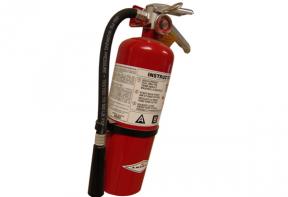Home workshop fire extinguisher tips
Make sure you have the right extinguisher ready to go
Test yourself. In 20 seconds or less, answer the following four questions:
1. Do you have a fire extinguisher in your shop?
2. Where is it exactly?
3. Is it functional or in need of a recharge?
4. What type(s) of fire(s) is it made for?
If you can’t answer all four, it’s definitely worth taking the time to make sure both you and your extinguisher are ready to go at a moment’s notice. After all, when it comes to fires, there’s a saying: “When seconds count, the fire department is only minutes away.”
Since there are multiple fire hazards in your shop, it is important that you have an extinguisher that is suited to the three types of fires that can occur:
Type A Burning solids such as wood, paper, rags, etc. Because a Type A extinguisher will contain water, it must not be used on Type B or C fires.
Type B Chemical fires, which can include oil, gasoline, solvents and alcohol, which are all common in the workshop. Type B extinguishers contain a dry chemical to smother the fire, making them ineffective on Type A and C fires.
Type C Electrical fires. Electrical fires require rapid cooling, and extinguishers generally contain CO2.
Type A/B/C units contain a chemical that both cools (for Type A and C) and smothers (for Type B) at the same time. For general shop use, a large combination (Type A/B/C) extinguisher is your best bet, as the chances of making matters worse by using the wrong type are eliminated.
Don’t let an oily rag or an errant spark destroy your shop. Take a few minutes and give your extinguisher the attention it deserves; it could be the best shop investment you ever make.
To leave a comment, please log in












No comments